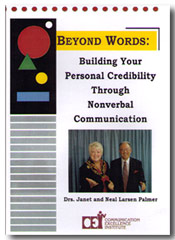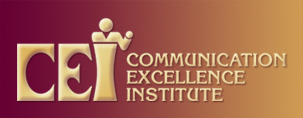In these challenging economic times, we believe that in a job search, you need to have everything going in your favor: your resume, your verbal presentation, your wardrobe, your manners, and your attitude. But what you may not be sure of is how you come across nonverbally. That’s what this issue of People Skills for Skilled People is all about.
At CEI, we are coaching many highly educated and experienced professionals now having to search for a job for the first time in 20 or 30 years. Understandably, people like them are apprehensive, but more than that, they’re often not up on the latest research and practice of job interviewing. The job search is a whole new world, what with monster.com, jobs.com and the many other online job search sites. Resume writing has changed, too, in step with Internet culture. And the interview itself has been greatly affected by the concepts of behavioral interviewing.
Professionals are turning to the Internet for the best possible ideas out there to make the most of a challenging situation. Luckily, there are tons of interviewing online articles on preparation, dress, attitude, ethics, and questions to ask and answer during an interview. You can see some of them by clicking on this link in Google:
Google Search: job interviewing
That’s not what this issue of People Skills for Skilled People is about, however. What we want to do here is explore the nonverbal dimension of interviewing, the part that constitutes 93% of your personal impact in any face-to-face situation. So let’s take a look at… |
Before we start, however, I can’t resist the urge to share one piece of interviewing philosophy that will put you ahead of at least 95% of your competition. Jan and I have conducted many interviews from the hiring side of the table, particularly for positions with our company.
Some typical phrases we have encountered are “This is exactly the job I’ve been looking for.” “This job will really help me build my resume.” “This job will be a great stepping-stone for my career.” And my all-time favorite, “I want this job to become your competition!”
You’re probably saying, “I’ve heard almost all these, too. Everybody uses them.” If you’ve come to accept this type of phrasing, I urge you to look for the missing part. See it yet? Right. No mention is made of what these people will do for THE HIRING COMPANY! HELLO!
We have a standard that weeds out anyone using this phraseology. It goes like this: No one hires you because it’s good for you. Employers only hire you for what you can do for them. As the interviewee, constantly be emphasizing in the interview how you’re going to increase that company’s bottom line, save it money, expand its services or products, or build its reputation among customers and market sector. Do not mention anything about how the job will benefit you.
Now, let’s turn to some nonverbal do’s and don’ts to ensure that you make the best impression possible in your next interview. In fact, the biggest part of the interview happens in the first 3.5 minutes: the time it takes to make a first impression. Let’s break down those critical 3.5 minutes.
The first three things another person notices about you are your ethnicity, your gender, and your age. None of us has any control over these three things. And what we know is that these three features are at the heart of all racism, sexism, and ageism. It’s also why so much legislation has been passed protecting us from discrimination around any of these. Just because we notice them first, doesn’t mean we should make a hiring decision based on them.
Now, let’s look at the rest of the elements that make up a first impression. Luckily, these are the things we can control:
- Your general appearance/dress
- Your facial expressions
- Your eye contact
- Your movement patterns
- Your use of personal space
- Your touch/handshake
You’re being evaluated on these in just a few seconds, even before you utter your first word. Be aware of them and manage them well, and you’ll be off to a great start. In the rest of this issue, we’ll explore the nonverbal features that enhance all these as well.
Now, you’re in the interview. You’ve got plenty to learn about the interviewer’s organization, and you have questions of your own. The biggest question on both of your minds is—will you fit in? Yes, a great deal of an interviewer’s time will be spent sizing up your qualifications for the job. But virtually unbeknownst to him or her, just as much time will be spent sizing up your social and emotional fit in the organization. How much of a team player will you be? How open to criticism will you be? How deftly will you handle conflict? How approachable will you be?
The final decision on these last “emotional” features of you will be based on how you come off nonverbally. The fact is you’ve been evaluated nonverbally even through that critical first impression. So let’s see what to look out for as you prepare to conduct yourself in the whole interview.
Posture
You’ll no doubt be offered a seat almost immediately. It will usually be a straight chair, rarely a swivel chair. The basic procedure for sitting for an interview involves these steps:
- Sit on the front part of the chair, leaning slightly forward. Never let your back touch the back of the chair throughout the whole interview. Never lean back in a swivel chair—or worse yet, twist back and forth.
- Feel free to rest your forearms on the chair’s arms as a neutral position. If the chair is armless, rest your palms gently on your thighs and slightly out of parallel.
- If you are at a table, lean forward so that your forearms rest on the edge of the table at a point midway between your elbows and your wrists.
- Have your arms out of parallel (one arm forward, one arm back). Symmetrical gestures suggest insecurity.
- Keep both hands visible at all times. An interviewer will be perplexed and/or suspicious of someone who keeps one or both hands under the table.
- Never touch one hand to the other.
- Always keep your solar plexus (midriff area) open. Especially at a table, moving one arm in front of you creates a barrier—not a real one, but one in the interviewer’s mind.
- Take up more body space than you usually do (2-3” outward movement with each arm). When not overdone, this creates an image of power and control.
- Keep your head straight up and down. This suggests stability. A tilted head looks unsure, flirtatious, or coy.
- Keep your chin level with the next horizontal surface. Interviewees who habitually carry their chin too high come off as arrogant—usually a deal-breaker in any interview.
Hands
Believe it or not, we live in a “hands” culture. Even in our language, “hands” can mean “people.” For instance, we say “We’re one hand short,” or “All hands on deck.” Because we put so much emphasis on hands, both your hands should be visible throughout the interview.
- As you gesture, lift your arms off the table to drive home key points. Gesture with your palms open and facing your interviewer.
- Avoid using fists. They’re seen as highly combative.
- Avoid pointing with the index finger. Use a whole outstretched palm instead of a pointing finger.
Eye Contact
- Look straight at the interviewer and concentrate on the color of his or her eyes. This conveys interest and warmth and makes eye contact easy and natural.
- If you must disengage to think of an answer, look down, not up. This eye movement implies you’re searching for an idea. Looking downward sends a message of “grounding” and stability. Looking up suggests confusion (having your head in the clouds).
Facial Expression
- Talk through a smile or pleasant expression. This connotes that you’re happy or pleased with what you’re talking about. A happy demeanor also suggests that you will be easy to work with. In the words of an 89-year-old WWII veteran down on his financial luck, who was interviewed by Good Morning America on a whistle-stop tour in October 2008, “A smile improves your face value.”
- Use the “eyebrow flash.” This quick up-and-down movement of both eyebrows together underscores important points, and for non-smilers serves as the equivalent of a smile.
There are quite a few other body signals—good and bad—that we can send, but if you use these, you’ll do fine nonverbally.
In our next edition of PSSP, we’ll share our favorite tips for making the best verbal impression.
We’re all going through unprecedented times. Keep the faith and remember that people who have gone through major transitions in times like this have often said that the changes in their lives were the best things that had ever happened to them.
Yours in good communication,
Neal & Jan Palmer |
If you’ve been following our issues of PSSP, you’ll know we’ve published a DVD of our classic presentation “BEYOND WORDS: Building Your Personal Credibility Through Nonverbal Communication.” In the spirit of our title of this issue, we’re suggesting this as a great help for anyone you might know who’s now interviewing for a new position or a step up in their current organization.
This 1.5-hour seminar with PowerPoints was recently presented to a group of 60 CEOs of corporations in Southern California. We think you’ll like it, and it could be of great help for anyone interviewing.
For those of you who have seen this presentation before, we hope it offers you a great refresher. For those of you who have been waiting for our most popular speech to come out on DVD, here it is!

Here’s our message on the back of the box:
Become more successful with clients, prospects, and colleagues!
Over 90% of your communication is nonverbal (positive or negative).
What messages are YOU sending?
What makes some people able to get their ideas enthusiastically accepted, while others are bypassed? Why are some people more believable than others? How do smart leaders gain people’s confidence? The answer is … by harnessing the power of nonverbal communication! People in your business and professional life are far more influenced—positively or negatively—by how you communicate nonverbally than by the words you say. In this presentation, Dr. Janet Larsen Palmer and Dr. Neal Larsen Palmer, principals of Communication Excellence Institute and nationally known experts on nonverbal communication, share practical techniques you can use to stand, gesture, and reach out to others nonverbally for greater impact and persuasiveness. You’ll be excited to try out everything you learn in this highly interactive presentation.
The Palmers coach university presidents, lawyers, business leaders, expert witnesses, politicians, fund raisers, and motivational speakers to use their nonverbal communication to make the greatest persuasive impact.
If you’d like to order our DVD, please click this link to our web store:
http://www.talk2cei.com/store/
You can either enter your credit card information directly into our secure site, or select “print and call” if you would prefer not to enter credit card information. Just call our office at 800-410-4CEI (4234). Our staff will be happy to take your order over the phone. The cost of our DVD is $29.95 plus tax and shipping & handling. |



